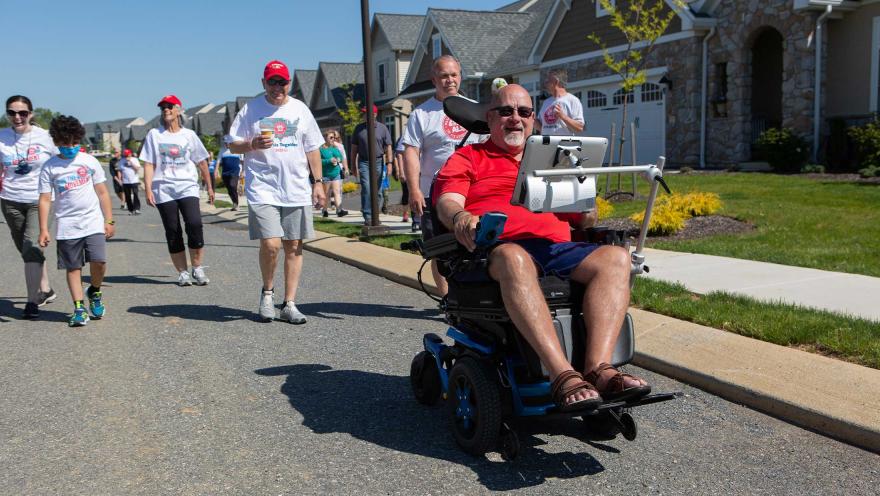A diagnosis of ALS is devastating, not only for the person who receives it, but for their family and friends as well. Taking the time to understand the disease’s progression and make plans to deal with the physical impact can help ease the burdens faced by people living with ALS and their caregivers, helping them live longer, stronger, more independent lives.
Prioritizing your needs and identifying solutions that will work best for you and your family helps with financial planning, gives you the necessary lead time to implement planned changes and provides peace of mind so that you will be prepared to handle changes that may arise on your journey with ALS. From home modifications and smart technology to assistive technology and communication devices, there are more options than ever before to help you adapt your living environment to meet your changing needs.
Home Modifications
Environmental modifications can help you to stay safe and retain your independence for as long as possible. They can also lower your caregiver’s risk for injury by making tasks such as assisting with transferring and repositioning less physically taxing. Home modifications can be permanent or temporary, low-‐tech or extremely sophisticated. Some are easy and inexpensive to implement; others require major renovations and are costly.
Three common needs that you may want to address in your plan for accessibility include getting in and out of the house, moving throughout the house, and ensuring safe access to bathroom facilities. From ramps and lifts to doorways and hallways, an occupational therapist can be a great resource to offer suggestions for addressing potential problem areas. Additional ideas and information can also be found in this pre-recorded webinar.
Smart Home Technology
Performing regular tasks can become difficult or even impossible for individuals with ALS, and the loss of independence can be deeply frustrating for many. “Smart” device technology outfitted within a home works in an assistive capacity to help restore and maintain a person’s autonomy and reduce their dependency on friends, family members, and caregivers.
These environmental controls are either voice- or touch-activated using tablets and smart phones with various apps. So, you can draw your curtains, turn the lights and television on, raise the temperature in the room, and lock the door in seconds, expending only the effort it takes to tap your phone a few times. The introduction of a digital assistant or smart speaker, such as a Google Home or Amazon Alexa, takes that even further by performing many of these actions with simple voice commands and can greatly improve accessibility and be life-changing for people living with ALS and their caregivers.
Assistive Technology
There’s a wide range of equipment and technology that can improve and maintain mobility and help manage ALS symptoms as the disease progresses. These devices can make it easier for people living with the disease to get around their homes, speak, and perform day-to-day tasks like bathing and going to doctor’s appointments, which makes life easier for both the person living with ALS and their caregiver.
From wheelchairs and ramps to respiratory aids and speaking devices, most experts recommend being proactive about making the necessary changes long before they are needed. Getting used to this equipment and incorporating it into your daily routine can be challenging, which means you should give yourself plenty of time to adjust to these additions to your home and daily life. And if you have difficulty obtaining this type of equipment, contact the care services team at your local chapter for resources and support.
While there can be various challenges involved as ALS progresses, there are many ways you can adapt to the physical impacts and still find enjoyment in the things the things you love to do. Being proactive and planning for what’s to come can improve quality of life and make ALS a livable disease.
For more information about navigating a life with ALS, visit our website HERE.


Comments
Being a caregiver is getting to be a challenge. My husband shows little interest in any thing inside or outside the home. Why is it that we cannot get all his Drs. To co-ordinate information regarding his care. There is a lack of interest on their part to solve the problem of edma in his legs and feet. His PT says he would get around better if they would help solve the edma. He would get. Around a lot better. We have been addressing this problem or about 3 years now, with it falling on deaf ears.
Hi Gail, I'm so sorry to hear that your husband is living with ALS. You may be interested in a multidisciplinary ALS clinic. The multidisciplinary care model brings together a team of health care professionals specially trained to address the needs of people living with ALS, allowing them to receive care from each discipline during a single visit. Learn more or find a clinic here: https://www.als.org/local-support/certified-centers-clinics
I go to the ALS CLINIC in Ann Arbor and they are very helpful in many areas. Might be a contact for you to try.
Join the conversation. Please comment below.